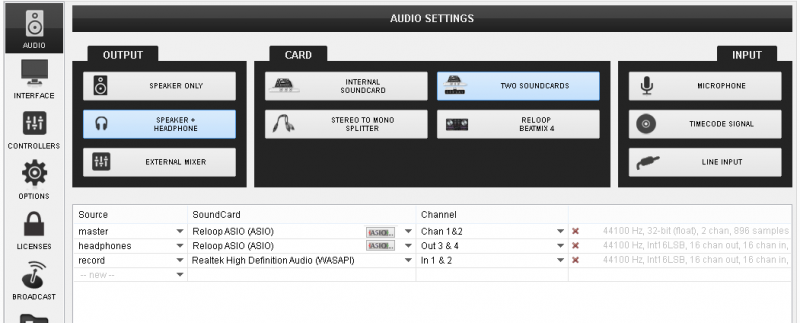RELOOP BEATMIX 4

INSTALLATION
Firmware & Drivers
Firmware: Update the firmware of the unit to the latest version from http://www.reloop.com/reloop-beatmix-4
Drivers (for Windows only): Install the latest Reloop ASIO drivers from http://www.reloop.com/reloop-beatmix-4
No drivers are required for Mac OSX computers
VirtualDJ Setup
Once VirtualDJ 8 is launched, a Login Window will appear to enter your virtualdj.com account credentials.
A Pro Infinity or a Pro Subscription License is required to fully use the Reloop Beatmix 4. Without any of the above Licenses, the controller will operate for 10 minutes each time you restart VirtualDJ.
http://www.virtualdj.com/buy/index.html

Select “Use Soundcard” in order VirtualDJ to use the pre-defined audio configuration for the unit. Speakers and Headphones need to be connected to the Beatmix 4 in this case.
Click to OK.

The unit is now ready to operate.
MIDI Operation
Find more details at http://www.virtualdj.com/wiki/VDJ8script.html
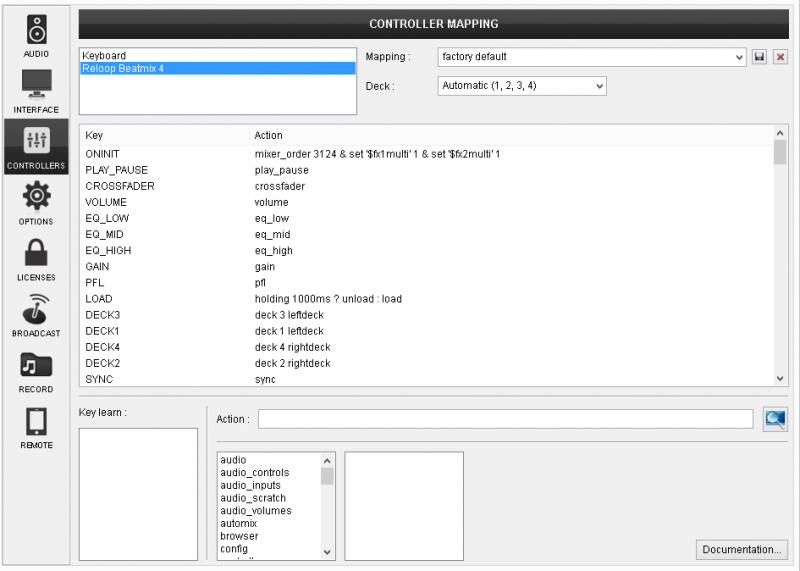
AUDIO Setup
Alternative Audio setups can be applied in the same window.
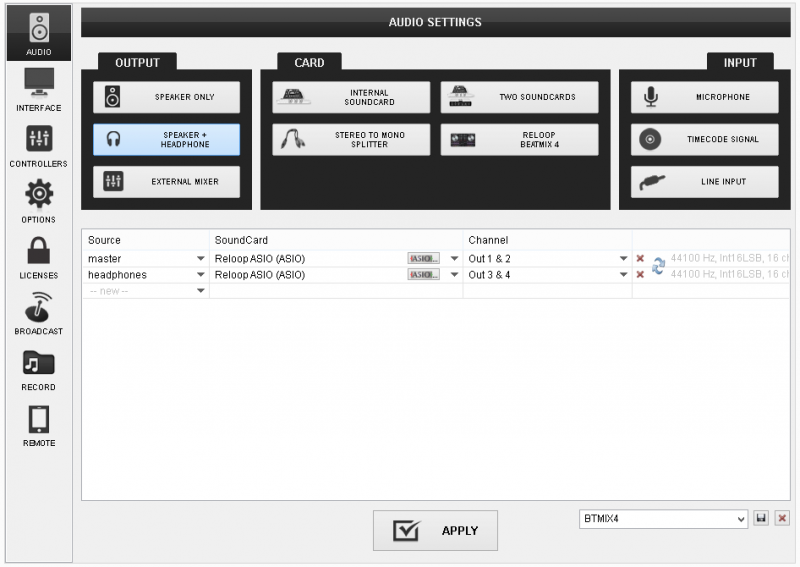
For further software settings please refer to the User Guides of VirtualDJ 8.
http://www.virtualdj.com/manuals/virtualdj8/index.html
LAYOUT

The functionality of each button and knob per section (as shown in the image below) will be explained in detail in the next chapters
A. Transport Controls
B. Tempo Controls
C. Effects
D. Pads
E. Mixer & Browser
TRANSPORT

- SHIFT. Press and hold this button to access secondary functions of other controls on the Beatmix 4.
- SYNC. Press this button to automatically match the corresponding Deck's tempo with the opposite Deck's (or the Master Deck’s if using a 4 decks Skin) tempo and phase. Hold SHIFT down and then press this button to set this deck as Master Deck (for 4 decks skins).
- CUP. Press this button to return to the last paused position and play the track from there when the button is released. Hold SHIFT down and then press this button to select the next available pitch range
- CUE. When the Deck is paused, you can set a temporary Cue Point by moving the Platter to place the Audio Pointer at the desired location and then pressing the Cue Button. During playback, you can press the Cue Button to return the track to this Cue Point. (If you did not set a Cue Point, then it will return to the beginning of the track.). If the Deck is paused, you can press and hold the Cue Button to play the track from the Temporary Cue Point. Releasing the Cue Button will return the track to the temporary Cue Point and pause it. To continue playback without returning to the Temporary Cue Point, press and hold the Cue Button, then press and hold the Play Button, and then release both buttons.
Press and hold Shift and then press this button to return to the beginning of the track. - PLAY/PAUSE. Play / Pause the track. Hold SHIFT down and then press and hold this button to play the track in reverse. Once the button is released, the track will continue to play from the position it would have been if the reverse play was never triggered (censor)
- DECK SELECT. Switch Left decks (1 and 3) and Right Decks (2 and 4). When the left DECK button is lit, the left side of the Beatmix 4 will control deck 3. When the right DECK button is lit, the right side of the Beatmix 4 will control deck 4.
Tempo & Jog
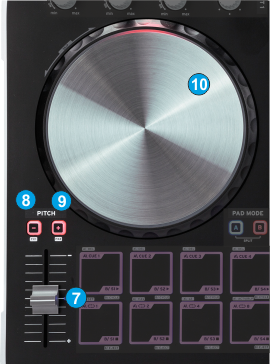
- PITCH. Controls the track's playback tempo. The blue led indicates that the pitch fader of the unit is on zero (center) position
- PITCH-. Press and keep holding this button down to temporary slowdown the speed of the track. Hold SHIFT down and then press this button to select the Single FX mode (see EFFECTS)
- PITCH+. Press and keep holding this button down to temporary speed up the track. Hold SHIFT down and then press this button to select the Multi FX mode (see EFFECTS)
- JOGWHEEL. Touch sensitive platter for scratching (vinyl mode), bending (CD Mode) or Seek mode. Touch the use the jogwheel to scratch and the outer ring to bend. Hold SHIFT down and then use the jogwheel to navigate through the track (seek mode)
EFFECTS
The Reloop Beatmix 4 offers 2 modes for the Effects control. In the Multi Effect mode, the effect units offer control for 3 Effect slots with 1 effect parameter for each, while the Single Effect mode offers a single Effect slot but more effect parameters. Use the SHIFT+PITCH-/+ (9/10) buttons to choose one or the other mode.

- FX1 knob.
In Multi Effect mode the knob controls the 1st parameter of the selected effect of FX Slot 1. Hold SHIFT down and use this knob to select the next effect for the Effect Slot 1. When the knob is at the minimum position (0%), the effect is not active (off). At any other position the effect is active (on).
In Single Effect mode the knob controls the 1st parameter of the selected effect. Hold SHIFT down and then use this knob to control the 4th parameter of the selected Effect - FX2 knob.
In Multi Effect mode the knob controls the 1st parameter of the selected effect of FX Slot 2. Hold SHIFT down and use this knob to select the next effect for the Effect Slot 2. When the knob is at the minimum position (0%), the effect is not active (off). At any other position the effect is active (on).
In Single Effect mode the knob controls the 2nd parameter of the selected effect. Hold SHIFT down and then use this knob to control the 5th parameter of the selected Effect - FX3 knob.
In Multi Effect mode the knob controls the 1st parameter of the selected effect of FX Slot 3. Hold SHIFT down and use this knob to select the next effect for the Effect Slot 3. When the knob is at the minimum position (0%), the effect is not active (off). At any other position the effect is active (on).
In Single Effect mode the knob controls the 3rd parameter of the selected effect. Hold SHIFT down and then use this knob to control the 6th parameter of the selected Effect - BEATS ENC.
In Multi Effect mode turn the encoder to move the track forward or backwards by 1 beat. Push the encoder to manually tap the tempo of the track.
In Single Effect mode turn the encoder to select the Effect. Push the encoder to activate (on/off) the selected Effect.
In both modes, hold SHIFT down and then turn the encoder to adjust (shift) the CBG of the track. Hold SHIFT down and then push the encoder to set the current track’s position as Fist (Down) Beat.
PADS

HotCues-Loop mode
Press the PAD MODE button A to set the PADs to Hotcues-Loop mode.
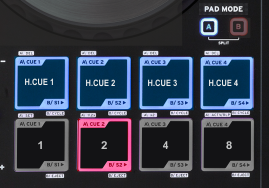
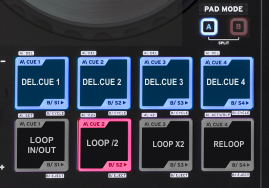
Each one of the 4 top pads assigns a Hot Cue Point (1 to 4) or returns the track to that Hot Cue Point.
When a Hot Cue Button is unlit, you can assign a Hot Cue Point by pressing it at the desired point in your track. Once it is assigned, the Hot Cue Button will light up blue.
Hold SHIFT down and then press one of the 4 top pads to delete its assigned Hot Cue Point.
Each one of the 4 bottom pads triggers a loop of a different size (in beats), as per the image.
Hold SHIFT and then use the 4 bottom pads to set and trigger a manual loop.
Pad Nr.5 is assigned as a smart loop button. Press the pad to set a Loop In (Entry) point. Press the same pad again to set a Loop Out (Exit) point and trigger the manual loop. Press once again to exit the loop.
Use Pads Nr.6 and 7 to half and double the size of the Loop.
Use Pad Nr.8 to trigger the last used Loop (reloop)
Sampler mode
Press the PAD MODE button B to set the PADs to Sampler mode.


Each one of the 8 pads triggers a sample slot from the selected Sampler Bank of VirtualDJ. If a bank has less than 9 samples, both sides of the Beatmix 4 will control the same samples. If a bank has more than 8 samples, the left side of the Beatmix 4 will control samples 1 to 8 and the right side samples 9 to 16. The Leds of the pads will be on if a sampler slot is loaded and will blink if plays.
Hold SHIFT down to receive additional parameters of the Sampler.
Use Pads 1 to 4 to select the 4 first (default) banks of VirtualDJ Sampler
Use Pads 4 to 8 to select the sampler trigger mode (On/off, Hold, Stutter and Unmute)
HotCues-Sampler mode
Press both the PAD MODE buttons A and B to set the PADs to HotCues-Sampler mode.
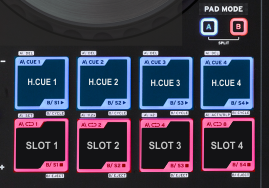
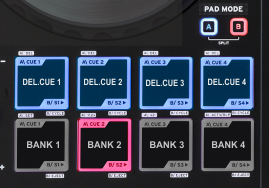
Each one of the 4 top pads assigns a Hot Cue Point (1 to 4) or returns the track to that Hot Cue Point.
When a Hot Cue Button is unlit, you can assign a Hot Cue Point by pressing it at the desired point in your track. Once it is assigned, the Hot Cue Button will light up blue.
Hold SHIFT down and then press one of the 4 top pads to delete its assigned Hot Cue Point.
Each one of the 4 bottom pads triggers a sample slot from the selected Sampler Bank of VirtualDJ. If a bank has less than 9 samples, both sides of the Beatmix 4 will control the same samples. If a bank has more than 8 samples, the left side of the Beatmix 4 will control samples 1 to 4 and the right side samples 9 to 12. The Leds of the pads will be on if a sampler slot is loaded and will blink if plays.
Hold SHIFT down and use the bottom Pads to select the 4 first (default) banks of VirtualDJ Sampler
MIXER & BROWSER
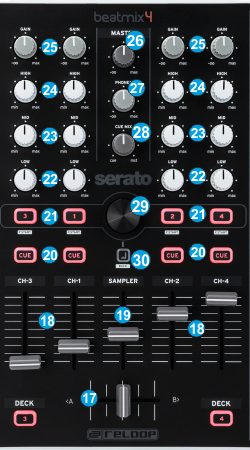
- CROSSFADER. Blends audio between the channels assigned to the left and right side of the crossfader.
- VOLUME. Adjust the Volume of each channel.
- SAMPLER VOLUME. Adjust the Volume of the Master Sampler Output.
- CUE. Press these buttons to send each channel/deck to the Headphones Output Channel (PFL)
- LOAD. Press these buttons to load the selected track from the Browser to decks 1 to 4. Hold SHIFT down and then press one of these buttons to enable the Fader Start on a deck.
- EQ LOW. Adjust the Low (Bass) frequencies for each mixer channel.
- EQ MID. Adjust the Mid frequencies for each mixer channel.
- EQ HIGH. Adjust the High (Treble) frequencies for each mixer channel.
- GAIN. Adjust the Gain of each mixer channel.
- MASTER VOLUME. Adjust the level of the Master Output. Hardware operation - movement not visible on the VirtualDJ GUI
- HEAPHONES LEVEL. Adjust the Volume Output of the Headphones Channel.
- HEADPHONES MIXING. Adjust how the Channels and the Master Output blend at the Headphones Channel.
- BROWSE ENC. Scroll through files of folders. Push the encoder to set focus to the Songs List.
Hold SHIFT down and then use the encoder to set focus to the SideView and cycle through the available views (Automix, Sidelist, Sampler, Karaoke, Clones) Hold SHIFT down and then push the encoder to open/close the Sideview. - BACK. Press this button to set focus to the Folders List. If focus is on the Folders List, use this button to open/close subfolders.
Hold SHIFT down and then use this button to set focus to the previous Browser Window (Folders List, Songs List and Sideview).
INPUTS & RECORDING
The Reloop Beatmix 4 does not offer any Input Channels for the built-in audio interface. Even though a Microphone Socket is offered at the front side of the unit, the signal is directly routed though the Master Output of the unit, therefore no Microphone line can be added in the audio configuration and the internal recording of VirtualDJ will not be able to record that.
If you still need to record or broadcast both your mix and the Microphone, the Master Output of the Beatmix 4 needs to be also routed to an Input of a different sound card (using apparently a Splitter Cable), and manually create the following audio setup.
